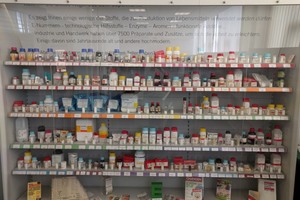Image may be NSFW.
Clik here to view.
Tucked away inside an unwelcoming-looking wholesale market in Hamburg, the German Food Additives Museum (Deutsches Zusatzstoffmuseum) is nearly as well hidden as the topic it covers. This fascinating little museum is dedicated to the thousands of different chemical substances lurking in the foods we eat on a daily basis.
For better or worse (and quite often, worse) a plethora of additives—emulsifiers, stabilizers, dyes, thickeners, sweeteners, preservatives, flavorings, and so on—are concealed in our meals. Yet the average consumer knows very little about what these chemical powders and liquids are, or how they're used.
The Food Additives museum shines a light on these mysteries. At this informative museum you can find out why we eat so much sawdust, see how much cheaper it is to use flavorings rather than the ingredients you'd use at home, and inspect a wall of every E-numbered food additive. (An E-number is awarded when a substance is examined by the EU’s Scientific Committee on Food; the E stands for “Europe.”) It also explains the history of horrific additives (like arsenic) with information on how the world gradually legislated against their use.
But while you might expect a food additives museum to portray a very biased view, the exhibits explains the history and current landscape of food additives in an informational rather than political way. The museum was founded in 2008 by the Hamburg Food Foundation (overseen by a pair of German food scientists) to educate people about the different kinds of additives, their purposes, production process, and any risks and side effects. The museum also gets into why so many of the additives that food producers are permitted to use don’t have to declared, even in some organic food products: While there are only some 360 E-numbers, there are tens of thousands of additives in food.
All that said, the museum itself is only half the fun—the other half is getting there. It is located in a wholesale market that's closed to the public most of the time. To gain entry you need you approach an imposing gateway that seems to suggest you are not welcome at it. Then you ring a buzzer to the museum on the wall to be let through a turnstile. At that point you're free to walk through the wholesale market area to the museum. If you're lucky a security guard will cycle up to you to ask what you are doing.
